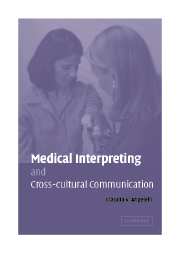Book contents
- Frontmatter
- Contents
- List of figures
- List of tables
- Acknowledgments
- List of abbreviations
- Prologue
- 1 Questioning invisibility
- 2 Communication in the medical encounter
- 3 A different set of lenses
- 4 California Hope: a public hospital in changing times
- 5 Putting it all together
- 6 Finding visibility
- 7 Interpreters' voices
- 8 Emerging metaphors and final words
- References
- Index
3 - A different set of lenses
Published online by Cambridge University Press: 22 September 2009
- Frontmatter
- Contents
- List of figures
- List of tables
- Acknowledgments
- List of abbreviations
- Prologue
- 1 Questioning invisibility
- 2 Communication in the medical encounter
- 3 A different set of lenses
- 4 California Hope: a public hospital in changing times
- 5 Putting it all together
- 6 Finding visibility
- 7 Interpreters' voices
- 8 Emerging metaphors and final words
- References
- Index
Summary
A curious analogy could be based on the fact that even the hugest telescope has to have an eye-piece no larger than the eye.
Ludwig Wittgenstein, Culture and Value (1980: 17e)Looking at the interpreter's role through different lenses
In chapters 1 and 2, we have examined a paradigm shift: from the interpreter as a conduit of information to a co-participant in the interaction. This shift helps to describe how interpreters do their jobs, but it does not tell us why interpreters make the choices they make. If they are co-participants, then what triggers their participation? Interpreters are full participants in communicative interactions together with doctors and patients. Like any of the other co-participants, interpreters bring their social baggage (their beliefs, attitudes, and cultural norms) to the medical encounter, and they exercise their agency. Interpreters, like all other human beings, participate in an interaction that does not happen in a social vacuum. Regardless of whether they perform the prescribed role or whether they become more visible by directing the flow of communication, their performance is constrained by the institution and the society in which the interaction is embedded. This inescapable fact has not yet been fully addressed (the exception being Davidson 2001). The interpreter's agency is present at three levels: interpersonal, institutional, and societal.
In the case of a doctor–patient interview in a public hospital, the doctor most likely belongs to the more dominant culture while the patient may belong to the less dominant culture.
- Type
- Chapter
- Information
- Medical Interpreting and Cross-cultural Communication , pp. 26 - 43Publisher: Cambridge University PressPrint publication year: 2004

